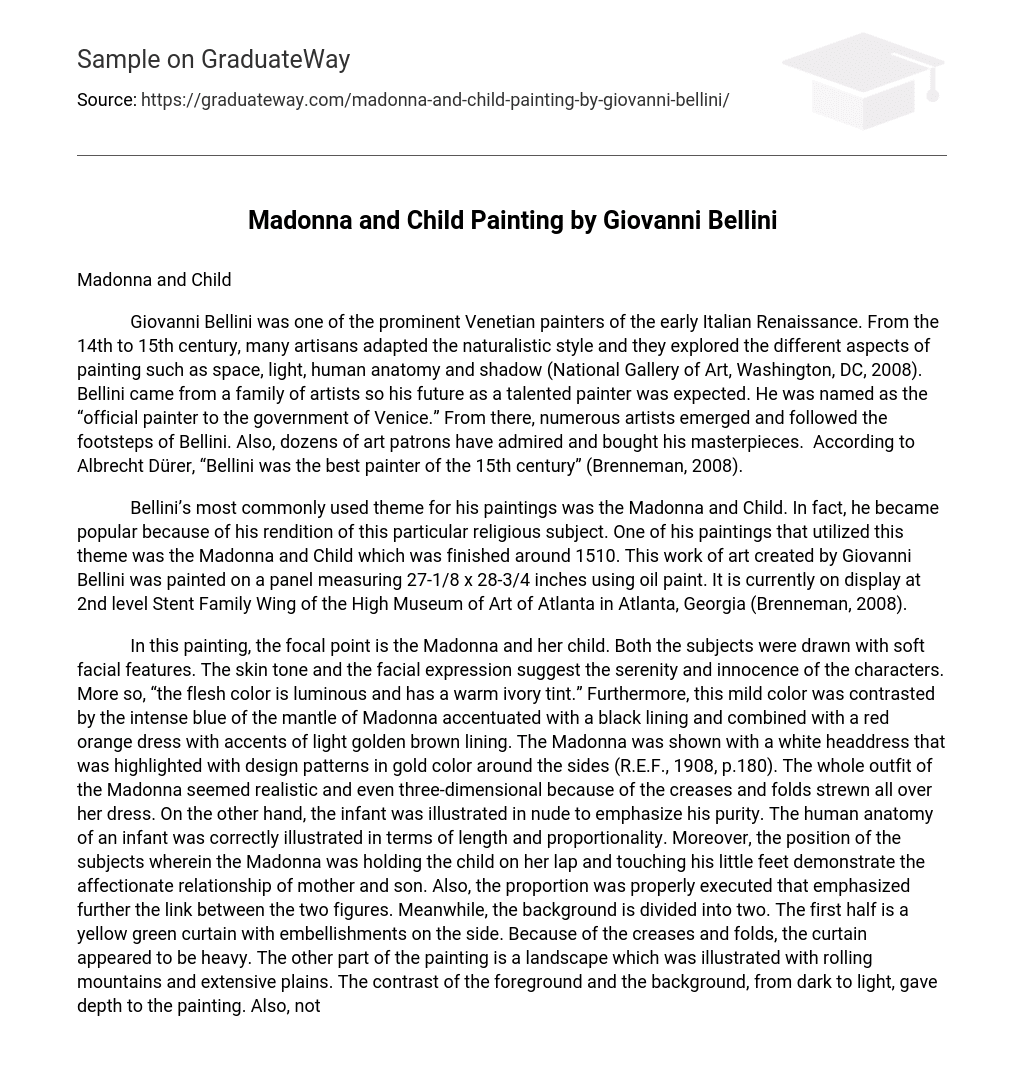Madonna and Child
Giovanni Bellini was one of the prominent Venetian painters of the early Italian Renaissance. From the 14th to 15th century, many artisans adapted the naturalistic style and they explored the different aspects of painting such as space, light, human anatomy and shadow (National Gallery of Art, Washington, DC, 2008). Bellini came from a family of artists so his future as a talented painter was expected. He was named as the “official painter to the government of Venice.” From there, numerous artists emerged and followed the footsteps of Bellini. Also, dozens of art patrons have admired and bought his masterpieces. According to Albrecht Dürer, “Bellini was the best painter of the 15th century” (Brenneman, 2008).
Bellini’s most commonly used theme for his paintings was the Madonna and Child. In fact, he became popular because of his rendition of this particular religious subject. One of his paintings that utilized this theme was the Madonna and Child which was finished around 1510. This work of art created by Giovanni Bellini was painted on a panel measuring 27-1/8 x 28-3/4 inches using oil paint. It is currently on display at 2nd level Stent Family Wing of the High Museum of Art of Atlanta in Atlanta, Georgia (Brenneman, 2008).
In this painting, the focal point is the Madonna and her child. Both the subjects were drawn with soft facial features. The skin tone and the facial expression suggest the serenity and innocence of the characters. More so, “the flesh color is luminous and has a warm ivory tint.” Furthermore, this mild color was contrasted by the intense blue of the mantle of Madonna accentuated with a black lining and combined with a red orange dress with accents of light golden brown lining. The Madonna was shown with a white headdress that was highlighted with design patterns in gold color around the sides (R.E.F., 1908, p.180). The whole outfit of the Madonna seemed realistic and even three-dimensional because of the creases and folds strewn all over her dress. On the other hand, the infant was illustrated in nude to emphasize his purity. The human anatomy of an infant was correctly illustrated in terms of length and proportionality. Moreover, the position of the subjects wherein the Madonna was holding the child on her lap and touching his little feet demonstrate the affectionate relationship of mother and son. Also, the proportion was properly executed that emphasized further the link between the two figures. Meanwhile, the background is divided into two. The first half is a yellow green curtain with embellishments on the side. Because of the creases and folds, the curtain appeared to be heavy. The other part of the painting is a landscape which was illustrated with rolling mountains and extensive plains. The contrast of the foreground and the background, from dark to light, gave depth to the painting. Also, not too much elements were incorporated in the landscape background so as not to over empower the Madonna and Child.
This simple painting exuded a solemn and an insightful mood because it represents the connection of the Virgin Mary with her son, Jesus Christ. These two were portrayed not in a divinely manner but more of a human-like portrayal to probably show that they are human beings just like everyone else. The absence of halos and saints signified that the artist wanted to personify the Madonna and Child so that the public can relate to them.
However, Bellini still stressed that these two must never be forgotten to be revered. The yellow green curtain symbolize honor and the “single bare tree in the upper right can represent the Crucifixion as well as to the tree in the Garden of Eden.” Also, the “balustrade with Bellini’s name separates the mortal viewer from the sacred figures, emphasizing the devotional aspect of the images” (Brenneman, 2008).
Overall, the Madonna and Child by Bellini is an exquisite piece of art that had captured the essence of religious icons. It combined divinity with humanity which was accentuated by the contrast of gentle and strong colors combined with Bellini’s ingenious play with light and shadow.
References
Brenneman, D.A. High Museum of Art of Atlanta. (2008). Madonna and Child by Giovanni Bellini. Retrieved October 6, 2008, from http://www.high.org/main.taf?p=2,1,5,1
National Gallery of Art, Washington, DC. (2008). Italian Painting of the 15th Century. Retrieved October 6, 2008, from http://www.nga.gov/collection/gallery/ita15.shtm
R.E.F. (1908). A Madonna and Child by Giovanni Bellini. The Metropolitan Museum of Art Bulletin, 3, 179-182.





